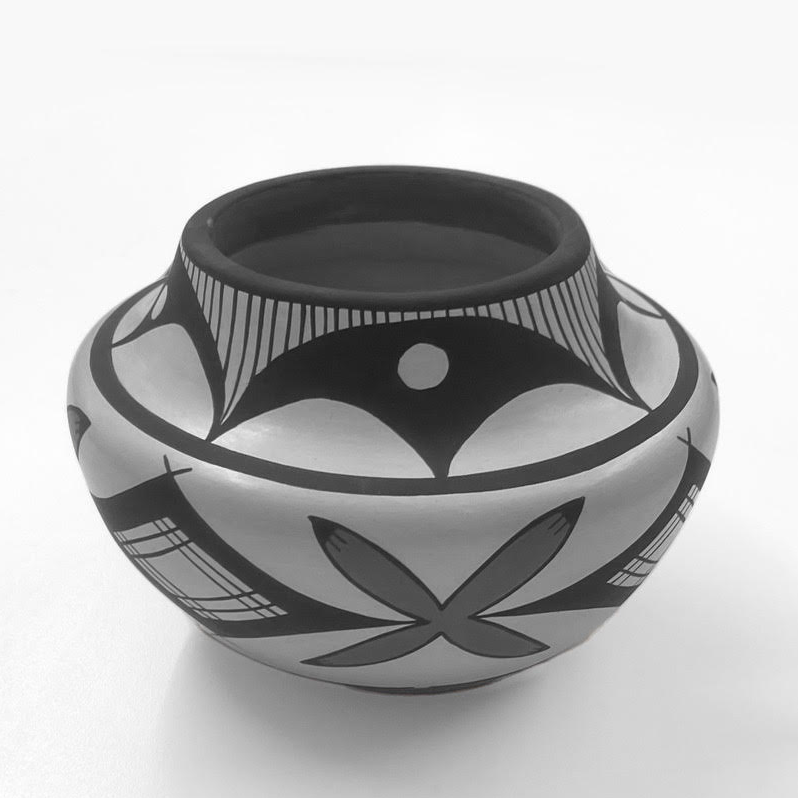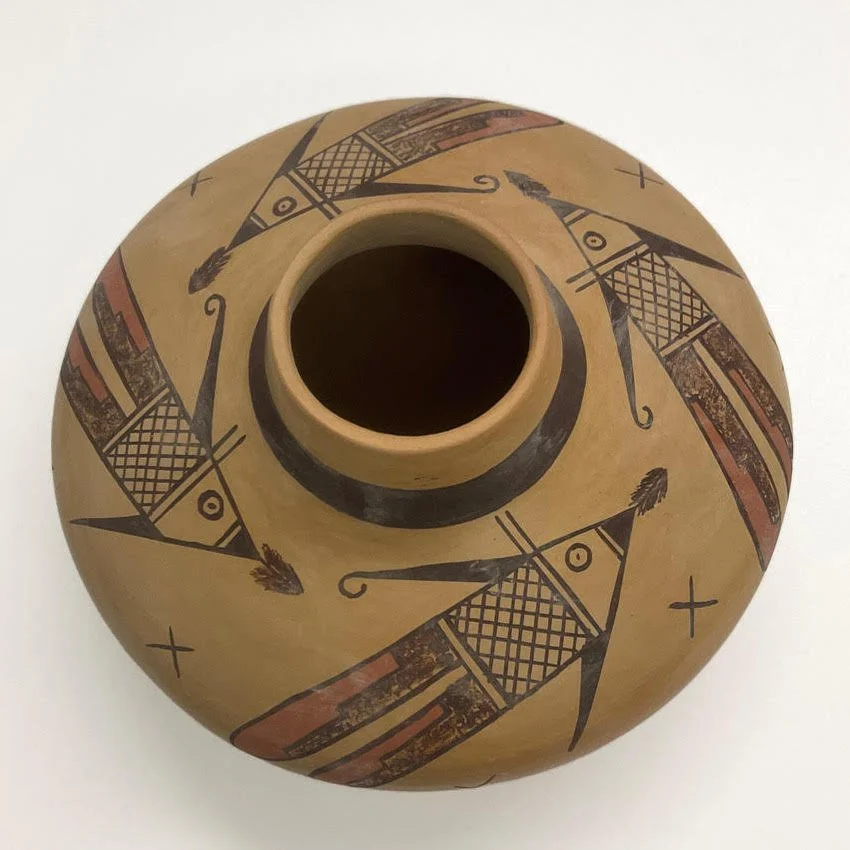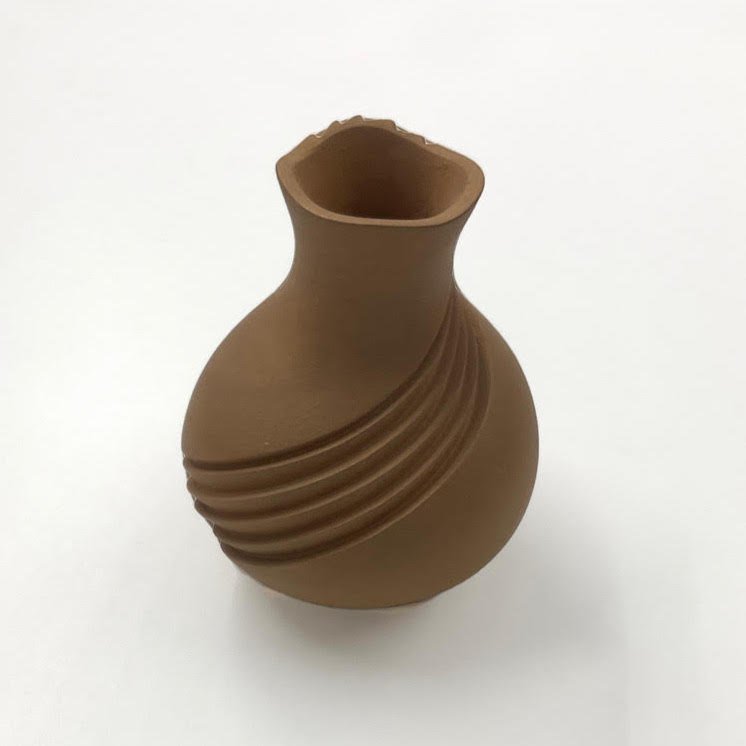A Treasure Trove of Two-Spirit Pottery
Selection of ceramic ware by Two-Spirit artists; Rane Richardson and Carse McDaniel Collection (2022-44), GLBT Historical Society.
A Treasure Trove of Two-Spirit Pottery
By Ramón Silvestre
November is National Native American Heritage Month, which makes it the perfect time to unveil one of our most spectacular recent archival acquisitions: the Rane Richardson and Carse McDaniel Collection.
This extraordinary collection consists of over a dozen rare pieces of museum-quality Native American pottery thrown and painted by Two-Spirit potters, including works by Navajo, Hopi, and Pueblo ceramicists. The collection draws attention to the unique and important cultural role of Two-Spirit people in Native American societies.
Among the artists included in this collection are:
Pot by Max Early; Rane Richardson and Carse McDaniel Collection (2022-44), GLBT Historical Society.
Max Early (Laguna) began painting pottery with his grandmother, Clara Acoya Encino, who accepted his help but emphasized that pottery-making was a woman’s job. After college he began throwing and firing his own pottery, and as one of only a handful of traditional potters active on Laguna Pueblo, New Mexico, he is dedicated to saving the tradition from extinction.
Egg by Caroline Elliot; Rane Richardson and Carse McDaniel Collection (2022-44), GLBT Historical Society.
Caroline Elliot (Santa Clara), who signed her early work as Forrest Naranjo, is based in Laguna Pueblo, New Mexico. She specializes in her family’s Sienna style or technique, also known as Staple style, which originated in the 1960s. Sienna firing results in ware that is an intermediary between the well-known black and red pottery of the Santa Clara Pueblo.
Hopi pot by Charles Navasie; Rane Richardson and Carse McDaniel Collection (2022-44), GLBT Historical Society.
Charles Navasie (Hopi-Tewa) began learning about pottery from his grandmother Joy at the age of 15. He works in traditional Hopi tan and yellow ware as well as in white ware, one of the hardest types of pottery to produce successfully.
Hopi pot by Dee Setalla; Rane Richardson and Carse McDaniel Collection (2022-44), GLBT Historical Society.
Dee Setalla (Hopi-Tewa) hails from Snowbird Canyon, Arizona, and began experimenting with pottery at age 6 under the guidance of his mother Pauline and his aunt Eunice, both well-known Hopi potters.
Phallus-shaped vessels by Mark Tahbo; Rane Richardson and Carse McDaniel Collection (2022-44), GLBT Historical Society.
Mark Tahbo (1958–2017, Hopi-Tewa), of First Mesa, Arizona, was an active potter from age 20. Tahbo was descended form a long line of outstanding potters and was known for extremely thin-walled, polished pottery vessels that won multiple awards at the Santa Fe Indian Market and the Heard Museum Annual Indian Fair. He produced two phallus-shaped vessels in the collection.
Santo Domingo-style pot by Robert Tenorio; Rane Richardson and Carse McDaniel Collection (2022-44), GLBT Historical Society.
Robert Tenorio (Kewa), of Kewa Pueblo, is one of the foremost Pueblo potters working today. He first learned the fundamentals of working with clay at the age of ten from family members, including his grandmother Andrea Ortiz. Today he is known for his polychrome pots created in the traditional Santo Domingo style, which typically features a red base and red interior and black designs painted on a buff background.
Vase by Dominique Toya; Rane Richardson and Carse McDaniel Collection (2022-44), GLBT Historical Society.
Dominique Toya (Jemez) is a trans potter from Jemez Pueblo in New Mexico. She serves on the board of the Southwestern Association for Indian Arts and sells her wares at its annual Indian Market in Santa Fe and at the Heard Museum Guild’s Indian Fair and Market in Phoenix. She works collaboratively with her mother Maxine Toya, and her brother Damian Toya is also a potter. Pieces by Maxine and Damian are also in the collection.
This remarkable collection was donated by Rane Richardson, a former Bay Area resident who collected Native American material culture with his partner Carse McDaniel, who passed away in 2021. Our archivists are currently working with the donor and with experts in the field to document as much information as possible about the artists and their lineage as possible, in keeping with both archival best practices and Native American tradition.
We are honored to accession these works of art to the archives to enhance our holdings documenting the lives of LGBTQ and Two-Spirit Native people. As part of its collection development policy, the GLBT Historical Society actively seeks to acquire more collections such as this one that document the intersectional lives of Native American people. If you have such materials and are interested in donating them, please get in touch with our archivists at reference@glbthistory.org.
Ramón Silvestre is museum registrar and curatorial specialist at the GLBT Historical Society. He is an expert in material culture studies and previously was a Visiting Fellow at the Smithsonian’s National Museum of Natural History.









